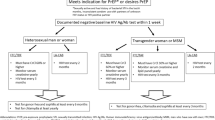Abstract
Perinatal transmission remains the main cause of HIV infection in the pediatric population. Treatment of HIV-infected children has become less of a problem in resource-rich countries with a remarkable decrease of perinatal infections, resulting in an effective prevention of mother-to-child transmission and antiretroviral treatment of HIV infection in pediatrics because of differences in drug pharmacokinetics, the lack of available licensed drugs, the use of different immunologic markers and age-related adherence issues. This review, for the general pediatrician, summarizes the most recent pediatric data and guidelines for treatment of HIV. Recommendations for when to initiate therapy are more aggressive in children than in adults, particularly in infants because disease progression in children is more rapid. The indications to start therapy differ by age and are based on international immunologic and clinical classification system for HIV infection. At present, combination regimens of at least three drugs are recommended. Moreover, therapies must also consider the potential complications in these children currently treated for a long time.

Similar content being viewed by others
Abbreviations
- ART:
-
antiretroviral therapy
- NRTI:
-
nucleotide and nucleoside reverse transcriptase inhibitor
- NNRTI:
-
non-nucleoside reverse transcriptase inhibitor
- PI:
-
protease inhibitor
- CDC:
-
Centers for Disease Control
References
Belzer ME, Fuchs DN, Luftman GS, Tucker DJ (1999) Antiretroviral adherence issues among HIV-positive adolescents and young adults. J Adolesc Health 25:316–319
Blanche S, Newell ML, Mayaux MJ et al (1997) Morbidity and mortality in European children vertically infected by HIV-1. The French Pediatric HIV Infection Study Group and European Collaborative Study. . J Acquir Immune Defic Syndr Hum Retrovirol 14:442–450
Centers for Disease Control and Prevention (CDC) (2007) Revised recommendations for HIV testing of adults, adolescents and pregnant women in health-care settings. MMWR Recomm Rep 55:1–17
Centers for Disease Control and Prevention (1994) 994 revised classification system for human immunodeficiency virus infection in children less than 13 years of age. MMWR Recomm Rep 43:1–10
Centers for Disease Control and Prevention (2001) Revised recommendations for HIV screening of pregnant women. MMWR Recomm Rep 50:63–85
Chakraborty R (2005) HIV-1 infection in children: a clinical and immunologic overview. Curr HIV Res 3:31–41
Cross Continents Collaboration for Kids (3Cs4kids) Analysis and Writing Committee (2008) Markers for predicting mortality in untreated HIV-infected children in resource-limited settings: a meta-analysis. AIDS 22:97–105
Dao H, Mofenson LM, Ekpini R et al (2007) International recommendations on antiretroviral drugs for treatment of HIV-infected women and prevention of mother-to-child HIV transmission in resource-limited settings: 2006 update. Am J Obstet Gynecol 197:S42–S55
Day E, Buckberry K, Sharland MR, Chakraborty R (2008) Novel treatment options for pediatric HIV infection. Curr Opin Investig Drugs 9:170–175
Durant J, Clevenbergh P, Halfon P et al (1999) Drug-resistance genotyping in HIV-1 therapy: the VIRADAPT randomised controlled trial. Lancet 353:2195–2199
Eley B (2008) Metabolic complications of antiretroviral therapy in HIV-infected children. Expert Opin Drug Metab Toxicol 4:37–49
Eley B, Nuttall J (2007) Antiretroviral therapy for children: challenges and opportunities. Ann Trop Paediatr 27:1–10
European Paediatric Lipodystrophy Group (2004) Antiretroviral therapy, fat redistribution and hyperlipidaemia in HIV-infected children in Europe. AIDS 18:1443–1451
Goetghebuer T, Haelterman E, Le Chenadec J et al (2008) Early vs deferred highly active antiretroviral therapy in HIV infected infants: a European Collaborative Cohort Study. Retrovirology 5(suppl 1):O25
Giaquinto C, Rampon O, Penazzato M et al (2007) Nucleoside and nucleotide reverse transcriptase inhibitors in children. Clin Drug Investig 27:509–531
Gray L, Newell ML, Thorne C et al (2001) Fluctuations in symptoms in human immunodeficiency virus-infected children: the first 10 years of life. Pediatrics 108:116–122
Green H, Gibb DM, Walker AS, Paediatric European Network for the Treatment of AIDS (PENTA) et al (2007) Lamivudine/abacavir maintains virological superiority over zidovudine/lamivudine and zidovudine/abacavir beyond 5 years in children. AIDS 21:947–955
HIV Paediatric Prognostic Markers Collaborative Study (2005) Use of total lymphocyte count for informing when to start antiretroviral therapy in HIV-infected children: a meta-analysis of longitudinal data. Lancet 366:1868–1874
Ikeda T, Ch’ng TW, Oleske JM (2007) Recommendations in pediatric antiretroviral therapy. Expert Opin Pharmacother 8:155–166
Lujan-Zilbermann J, Rodriguez CA, Emmanuel PJ (2006) Pediatric HIV infection: diagnostic laboratory methods. Fetal Pediatr Pathol 25:249–260
Luzuriaga K, McManus M, Mofenson L, PACTG 356 Investigators et al (2004) A trial of three antiretroviral regimens in HIV-1 infected children. N Engl J Med 350:2471–2480
McKellar MS, Callens SF, Colebunders R (2008) Pediatric HIV infection: the state of antiretroviral therapy. Expert Rev Anti Infect Ther 6:167–180
Prendergast A, Tudor-Williams G, Jeena P et al (2007) International perspectives, progress and future challenges of paediatric HIV infection. Lancet 370:68–80
Resino S, Resino R, Micheloud D, Spanish Group of Paediatric HIV infection et al (2006) Long-term effects of highly active antiretroviral therapy in pretreated, vertically HIV type 1-infected children: 6 years of follow-up. Clin Infect Dis 42:862–869
Starr SE, Fletcher CV, Spector SA, PACTG 382 Study Team. Pediatric AIDS Clinical Trials Group et al (2002) Efavirenz liquid formulation in human immunodeficiency virus-infected children. Pediatr Infect Dis J 21:659–663
Van der Linden D, Hainaut M, Goetghebuer T et al (2007) Effectiveness of early initiation of protease inhibitor-sparing antiretroviral regimen in human immunodeficiency virus-1 vertically infected infants. Pediatr Infect Dis J 26:359–361
Violari A, Cotton MF, Gibb DM et al (2008) Early antiretroviral therapy and mortality among HIV-infected infants. The CHER Study Team N Engl J Med 359:2233–2244
Working Group on Antiretroviral Therapy and Medical Management of HIV-infected children (2008) Guidelines for the use of antiretroviral gents in pediatric HIV infection and pediatric antiretroviral drug information. http://AIDSinfo.nih.gov
WHO (2008) Paediatric HIV and treatment of children living with HIV. www.who.int/hiv/paediatric/en/index.html
Conflict of interest
The authors certify that they have no relationship with the organizations that sponsored the research.
Author information
Authors and Affiliations
Corresponding author
Rights and permissions
About this article
Cite this article
Brichard, B., Van der Linden, D. Clinical practice treatment of HIV infection in children. Eur J Pediatr 168, 387–392 (2009). https://doi.org/10.1007/s00431-008-0914-8
Received:
Accepted:
Published:
Issue Date:
DOI: https://doi.org/10.1007/s00431-008-0914-8



